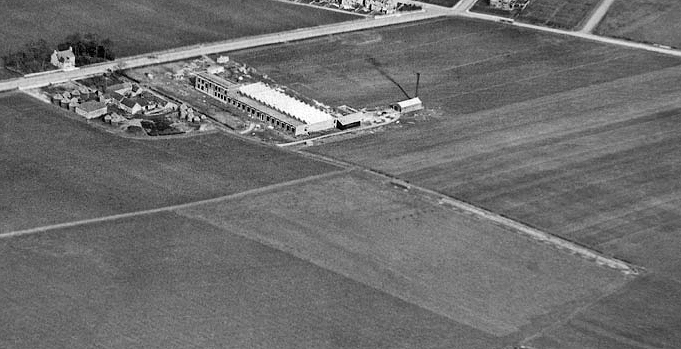KB History – Chapter 1: The seeds of a new campus, 1919–1920
The Great War had been over for less than a year, but the Government had already recognised several years earlier that the war effort had been hampered by a shortage of doctors, surgeons, scientists and engineers, a shortage that would only get worse with the growing realisation by the public and authorities that qualified men and women were vital to the country’s victory in war and prosperity in peace. The war had also highlighted the inadequacies of state funding (in sharp contrast to Germany and Austria), which would lead to a four-fold increase in available funds by 1920.
In the 19th century the emphasis had been on lectures to large numbers of students, but an increase in specialisms within the sciences had led to the growth of smaller departments within the faculty, and an increased demand for laboratory facilities for teaching and research.
In addition, the war had had a major impact on the number of science students at Edinburgh: from 434 in 1913 to a low of 147 in 1916, post-war numbers would surge to 1086 by 1919, with an influx of students whose degrees had been interrupted or deferred, alongside the normal admissions, which only increased the pressure on teaching and research.
By the beginning of the 20th century, therefore, the rapid expansion of science facilities in the Old College and surrounding premises had reached a critical point, relieved only temporarily by the removal of Mathematics to Chambers Street, and Agriculture and Forestry to George Square.
The Chemistry laboratories, located in floors above the Medical School at Teviot Place, had become hopelessly inadequate, and plans for a new Department of Chemistry in High School Yards had been abandoned at the outbreak of war in 1914. The Departments of Engineering, Natural Philospophy and Geology were also seriously short of teaching and research space in the centre of town, and new laboratory and experimental facilities were urgently required. (Engineering in particular had undergone rapid expansion, from 15 undergraduates in 1901 to 120 students in 1911.) The newly instituted Chair of Zoology in 1919 was also a trigger for expansion, requiring new accommodation.
Many possible plans were discussed, motivated mostly by a desire to keep all departments in the centre of town, but none of these were more than short-term solutions. Principle Sir James Alfred Ewing was looking for more than simple conversion of old city-centre sites, which would always restrict future growth, and so he looked to the sparsely populated south of the city…
A new site “in the middle of nowhere”
Undergraduate teaching had taken place at the Royal Observatory on Blackford Hill in the south of the city since its construction only eighteen years before the war, and the nearby West Mains Farm was an appealing prospect for expansion. This low-cost open field with main road access was ideal for construction, with plenty of land for future developments, in an unpolluted environment for scientific experiments. The two-mile journey from existing facilities was seen as a disadvantage, but the prospect of new, purpose-built teaching and research buildings was highly influential in the final decision. Thus, West Mains Farm was purchased in 1919 by the University for the relocation and expansion of its science departments, with an initial emphasis on Chemistry, Zoology and Geology. 90 acres of the 115-acre site were set aside for development, the remainder being leased to the Craigmillar Golf Club.
Site preparation for the new Chemistry Building began in November 1919. Its innovative layout was based on ideas and sketches by the head of the department, James Walker, whose foresight was to design a building with teaching rooms interspersed with numerous research laboratories. It shared many features of industrial buildings, including the saw-tooth roof with northern lighting, and large windows to provide adequate illumination, an unusual architectural feature at that time. Walker also eschewed the use of elaborate building materials – most of the building was constructed from red brick – preferring to spend the money on internal features.
One of Walker’s innovative decisions – originally criticised, but now recognised as forward-thinking – was to design the building to be constructed in phases, with future extensions in mind; his foresight was justified when the second floor was added in the early 1950s.

Aerial photo of King’s Buildings in early 1921; West Mains Farm lies to the left of the Chemistry Building, under construction.
A Royal opening and naming
While discussions were being held prior to the purchase of the site, the University launched a major appeal for funding of its planned new developments, which were endorsed by King George V. The King was then invited to lay the foundation stone for the Chemistry Building, still under construction in mid-1920, and as part of the ceremony the King gave his permission to use his name collectively for the science laboratories.
At 2pm, on the 6th of July 1920, The King’s Buildings campus officially came into existence.
Peter Reid, College of Science and Engineering
We are indebted to the following sources of information for this brief history:
- “Science at the University of Edinburgh 1583–1993”, Birse;
- “Building Knowledge: an Architectural History of the University of Edinburgh”, Haynes & Fenton;
- “The University of Edinburgh: an Illustrated History”, Anderson, Lynch & Phillipson;
- the collected notes of Des Truman, and many other College and University sources.




Recent comments